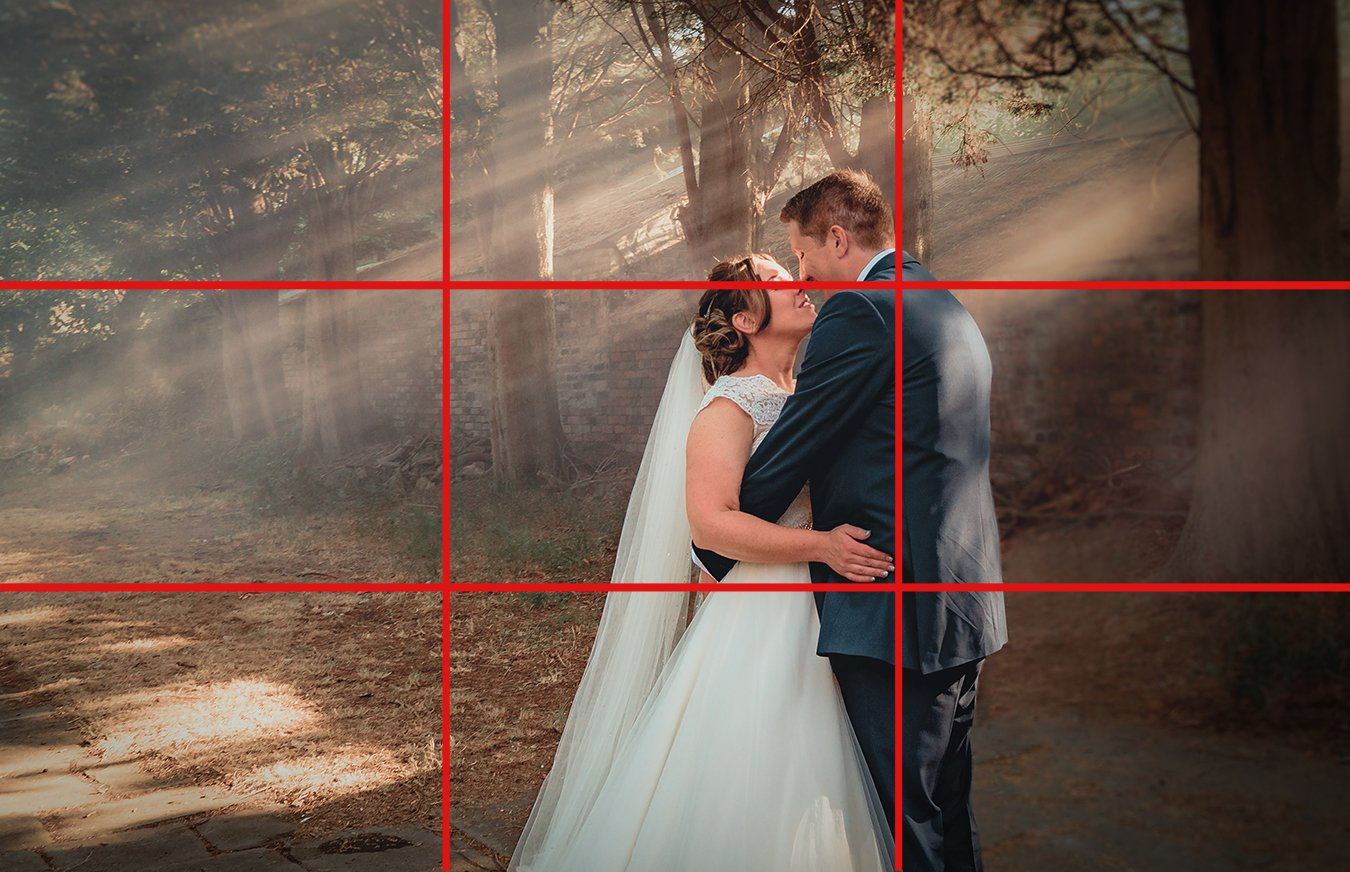Understanding the Rule of Thirds in Bridal Photoshoot Composition

Photography is an art where every shot taken has to be a composition of different elements put together to tell an appealing story. The Rule of Thirds is one of the most used techniques by photographers.
This may be what sets apart how an image appeals, be it a bridal shoot that captures moments full of emotion, detail, and ambiance of the time of the day with accuracy. The idea behind how the Rule of Thirds applies within the framework of a bridal photoshoot enables one to capture stunningly attractive and emotionally touching pictures, composed properly to bring forth the beauty of a bride and the essence of the day in itself.
The rule of thirds is a fundamental concept in visual composition and is defined by mentally envisioning an image divided into nine equal parts through the placing of two equally spaced horizontal lines and two equally spaced vertical lines. Where they intersect, four points create what are known as the “power points” of the image.
The rule of thirds says that, rather than placing the most informative elements of the scene in or near the actual center of the frame, a more interesting arrangement might place important elements along or near one or more of these lines or at an intersection. The principle of the rule of thirds is based upon one very straightforward yet powerful fact: By placing the most important elements of your composition off-center, the viewer will easily be able to focus on the subject.
The approach works because centering the subject tends to give the picture a sense of static, which is less creative, while placing elements in other points creates an involvement of the gaze across the entire picture, bringing more balance and harmony to it. The rule of thirds is used in creating this difference during the photoshoot to capture the emotional, motion-oriented, and beautiful frames with tender delicacy.
In bridal photography, it’s not just about taking a picture of a bride on her special day but telling a love and joy story of the essence of that moment in a wedding. Composition enhances this telling ability of the photos through drawing the attention of the viewer to the main elements in the frame: probably the expression on the bride’s face, the wedding dress, and all the other minute things that can be included in the scene-rings, flowers, and patterns, among others, and those forms of ornamentation found at the venue. Good composition beautifies the photo while telling a story at the same time. The Rule of Thirds, when applied appropriately, brings order in the image without losing its organic feel. During a bridled shoot, everything from the bride’s posture to the backdrop can be enhanced to create a visual flow that will make the image stand out. Let’s look a little further into how to apply this rule properly in bridal photography.
The bride is usually the main subject in photographing a bride, and often it is desired that her beauty, dress, and emotions be the focus. Applying the Rule of Thirds here, the following points must be considered:
Do not compose the bride centered within the frame but instead place her along one of the vertical lines of the Rule of Thirds grid.
It makes this photo feel so organic because it leaves space within the frame for other important features such as the background, other guests, or some props that add meaning to the scene. A bride could be at the right or left side of the frame to leave some space for her veil or bouquet to come into the shot.
Using the Power Points: The four intersections of the grid are really important since that is where the viewer’s eye goes. A bride’s face at one of those points helps bring out her expression and involve the viewer in it more. For example, if she’s gazing off into space, having her eyes at one of the power points can balance out and give the image more life.
Most of the time in bridal portraits, movement happens big time. Be it the bride twirling in her gown, walking down the aisle, or looking over her shoulder, creating space in the direction of her movement by using the Rule of Thirds helps the photo feel dynamic. If she’s walking to the left, place her on the right side of the frame, giving her space to move-in other words, creating a sense of motion and anticipation.
The dress could be the most important factor in a bridal shoot and often will be the main focus of a photograph. Applying the Rule of Thirds accentuates the dress, creating a much more pleasing composition. Here’s how you might do this:
If a bride is in a full-view pose with her dress, offset the bride to the side of your frame. Her tulle may spill across a majority of the frame and be in all its glory. This focuses on the actual design of a dress as usually the bride’s face or the pose is enticing.
Most bridal shoots are done at various, very beautiful venues that have exquisite architectural or natural elements in the background. You can place the bride off-center using the Rule of Thirds so that the background may add to the overall composition without overwhelming the main subject. For example, tall trees, elegant archways, or stained-glass windows can frame up a wonderful backdrop without overwhelming the bride’s dress.
Bridal photography often includes close-up shots of details-the lace on the dress, the bouquet, or the intricate beadwork. While framing these details, the Rule of Thirds should be applied so that the focus remains on the details while giving context to the picture.
For instance, just in case you are engaging in photographing a close-up of her hand that can be holding this bouquet, remember to place this hand of this bride on just one of the indicated power points together with some features of the composing background left, which allows several of them as it may apply.
While the focus of a bridal photo shoot is the bride herself, several participants make up a picture: bridesmaids, groomsmen, and family. The Rule of Thirds will help in composing and creating harmony within a group.
When photographing the bride and her bridal party, try to avoid lining them up straight across, with or directly centered within the frame. By placing some members of the group off-center, you create a more dynamic and interesting picture. You might place the bride at one of the intersections and the bridesmaids or groomsmen to either side along the lines of the grid. This composition draws the viewer’s eye into the bride while allowing the group to appear as one.
The Rule of Thirds can also be applied in composing shots of the group with aspects of the environment, such as outdoor settings or indoor venues. The bridal party can be placed along the vertical lines of the grid, with the venue or landscape framed naturally by the surrounding space. This balances the subjects within the frame and further creates a harmonious interaction between the bride, her party, and the location.
In bridal photography, the environment is as important as the bride. The location and surroundings are great contributors to the mood of the image. The use of the Rule of Thirds when framing the environment could give a sense of depth and dimension to the shot.
The lawns, gardens, parks, or beach outskirts could be framed, minutely following the rule of thirds, while keeping the bride in the center. For instance, the horizon can be on one of the horizontal lines while placing the bride at one of the intersections to fill up the rest of the frame with the background without overcasting the subject.
Indoor marriage places like churches, ballrooms, or ancient buildings make use of the rule for giving structure where the ornate architecture is to be balanced with the bride. This guides whether one is framing grand archways, chandeliers, or soft light at a venue with the rule of thirds, so the environment complements and does not overwhelm the bride.
The rule of thirds is but an important tool within bridal photography to enhance the composition and storytelling of these images. This pushes the photographer away from placing the bride smack in the middle of every photo to creating a dynamic, engaging, well-balanced composition. By applying the Rule of Thirds, photographers are allowed to emphasize, for example, the beauty of a bride, highlight the importance of a wedding dress, show the emotions of the day, and crop the environment in a manner which supports the story.
Remember that although the Rule of Thirds is such a strong element, it’s one of many in the photographer’s toolbox. Creativity, intuition, and an understanding of emotions and story of the day-all produce breathtaking bridal photos. With the Rule of Thirds incorporated thoughtfully, photographers can elevate their compositions so every shot can be a masterpiece to relish for generations onwards.
SEO Focus Keywords: Rule of Thirds, bridal photography composition, bridal photoshoot tips, wedding photography, composition techniques, off-center composition, wedding dress photography, framing bridal photos, bridal party composition, creating dynamic bridal photos, storytelling in bridal photography, enhancing bridal portraits, photographic techniques for weddings, power points in composition, photography composition rules, visual composition in wedding photography.

